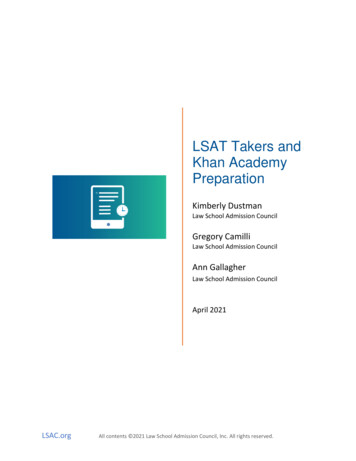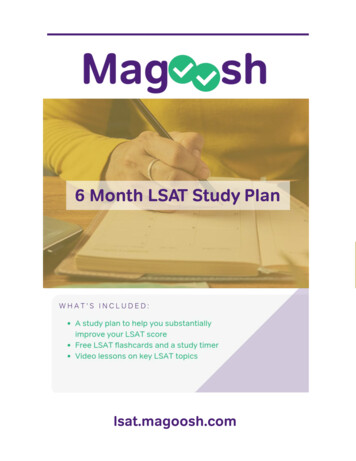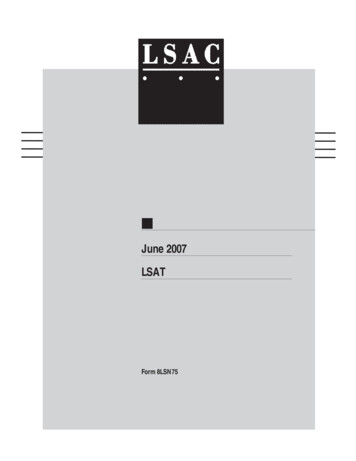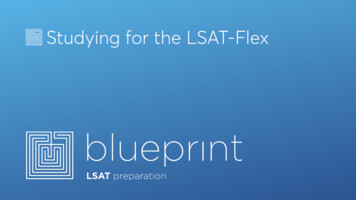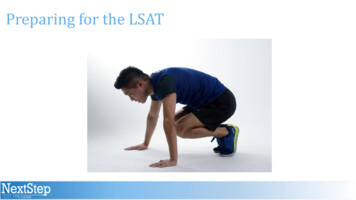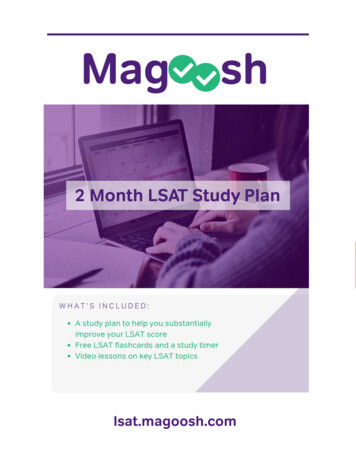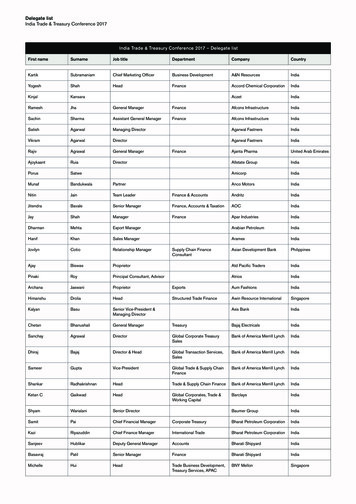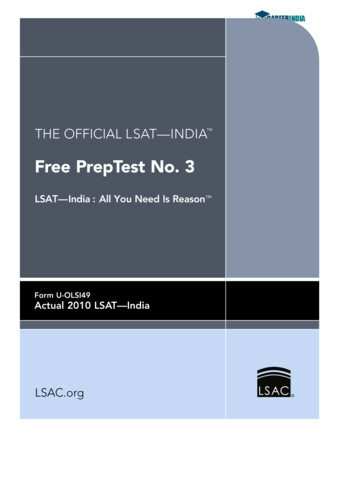
Transcription
Free PrepTest No. 3comTHE OFFICIAL LSAT—INDIA eerindia.LSAT—India : All You Need Is Reason Form U-OLSI49www.carActual 2010 LSAT—IndiaLSAC.org
TABLE OF CONTENTS Introduction to the Law School Admission Test—India.1 Scoring .1 The Question Types .1 Reading Comprehension Questions .1 Analytical Reasoning Questions .2 Logical Reasoning Questions .3 Taking the PrepTest Under Simulated Conditions.4 Answer Sheet .5 The PrepTest .7rindia.com Answer Key.38eeThe Law School Admission Council (LSAC) is a nonprofit corporation whose members are more than 200 law schools in the UnitedStates, Canada, and Australia. Headquartered in Newtown, PA, USA, the Council was founded in 1947 to facilitate the law schooladmission process. The Council has grown to provide numerous products and services to law schools and to more than 85,000 lawschool applicants each year.arAll law schools approved by the American Bar Association (ABA) are LSAC members. Canadian law schools recognized by aprovincial or territorial law society or government agency are also members. Accredited law schools outside of the United Statesand Canada are eligible for membership at the discretion of the LSAC Board of Trustees; Melbourne Law School, the University ofMelbourne is the first LSAC-member law school outside of North America.cLSAC does not engage in assessing an applicant’s chances for admission to any law school; all admission decisions are made byindividual law schools.wwLaw School Admission Test—India, LSAT—India : All You Need Is Reason, and Law School Admission Council are trademarks of the LawSchool Admission Council, Inc. 2012 by Law School Admission Council, Inc.wAll rights reserved. No part of this work, including information, data, or other portions of the work published in electronic form, maybe reproduced or transmitted in any form or by any means, electronic or mechanical, including photocopying, recording, or by anyinformation storage and retrieval system, without permission of the publisher. For information, write: Communications, Law SchoolAdmission Council, 662 Penn Street, PO Box 40, Newtown PA 18940-0040, USA.
INTRODUCTION TO THE LAW SCHOOL ADMISSION TEST—INDIALSAT—INDIA : ALL YOU NEED IS REASONThe LSAT—India is a test of reasoning and reading skills, not a test to see whether you happened to have memorizedthe right facts or equations. You can also be assured that each LSAT—India question will have a single answer that isclearly best. Before you ever see the questions, each is subjected to exacting reviews by at least 10 professionals withadvanced degrees in fields such as logic, English, and linguistics.THE QUESTION TYPESww.careecoma.Credit is given for each question a test taker answerscorrectly, and all questions count equally. There is nonegative marking or penalty for guessing, so a candidateshould answer each and every question. Test scores arereported on a percentile basis, comparing eachcandidate’s performance to that of the others within hisor her candidate group (Five-Year Integrated LL.B.Programme or Two-Year LL.M./ Three-Year LL.B.Programme). Scores for one candidate group cannot becompared to those for the other candidate group sincethey are based on group performance. So, for example, anundergraduate candidate earning an LSAT—India score of82.5 has performed better on the test than 82.5 percent ofthe total undergraduate candidate pool. This score doesnot indicate what the candidate’s standing would be withinthe post-undergraduate candidate pool. Note also thatthis score does not mean that the candidate answered 82.5percent of the LSAT—India questions correctly. Thus,LSAT—India scores tell law schools the relative strength ofwThe multiple-choice questions that make up the LSAT—India reflect a broad range of academic disciplines and areintended to give no advantage to candidates from aparticular academic background. The LSAT—India doesnot include questions requiring the mastery of any specificdiscipline or set of facts. For example, it does not test acandidate’s knowledge of history, political theory, or evengeneral knowledge. Rather, it is a test of important criticalthinking skills that a student has acquired over his or hereducational lifetime. Thus, the LSAT—India is differentfrom other legal-education admission tests used in India. Itmeasures a different set of skills and, even for thoseadmission tests that do partially address critical thinking,it measures those skills in different ways.The four sections of the test contain three differentquestion types. The following material presents a generaldiscussion of the nature of each question type and somestrategies that can be used in answering them.rinSCORINGthe critical-thinking skills measured by the test for eachcandidate in comparison to the others in his or hercandidate pool.diThe LSAT—India is a test of acquired, high-level reading,informal reasoning, and deductive reasoning skills,developed specifically for use by law schools in India.Although modeled on the Law School Admission Test(LSAT), it is adapted to the specific needs of Indianlegal education.Critical-thinking skills are key to success in the practiceof law throughout the world. The education of successfullawyers begins with assessing critical thinking skills duringthe law school admission process.This PrepTest is a valuable tool for preparing for theLSAT—India. It is the actual 2010 LSAT—India. It consistsof four, 35-minute sections of multiple-choice questions—one Analytical Reasoning section, one ReadingComprehension section, and two Logical Reasoningsections. You can use this practice test most effectively bytaking it under timed conditions as outlined in “Taking thePrepTest Under Simulated Conditions” on page 4 and onthe reverse side of the sample answer sheet.We wish you great success with the test and your pursuitof a law degree.Reading Comprehension QuestionsThe purpose of LSAT—India Reading Comprehensionquestions is to measure the ability to read, withunderstanding and insight, examples of lengthy andcomplex materials similar to those commonly encounteredin law school. The Reading Comprehension section of theLSAT—India contains four sets of reading questions, eachset consisting of a selection of reading material followedby five to eight questions. The reading selection in three ofthe four sets consists of a single reading passage; theother set generally contains two related shorter passages.Sets with two passages are a variant of ReadingComprehension called Comparative Reading.Reading selections for reading comprehension questionsare drawn from subjects such as the humanities, the socialsciences, the biological and physical sciences, and issuesrelated to the law. Reading comprehension questions1
require you to read carefully and accurately, to determinethe relationships among the various parts of the readingselection, and to draw reasonable inferences from thematerial in the selection. The questions may ask about thefollowing characteristics of a passage or pair of passages: the main idea or primary purpose; the meaning or purpose of words or phrases used; information explicitly stated; information or ideas that can be inferred;Note transitions from one idea to the next and examinethe relationships among the different ideas or parts of apassage, or between the two passages in comparativereading sets. Consider how and why an author makespoints and draws conclusions. Be sensitive to implicationsof what the passages say.You may find it helpful to mark key parts of passages.For example, you might underline main ideas or importantarguments, and you might circle transitional words—“although,” “nevertheless,” “correspondingly,” and thelike—that will help you map the structure of a passage.Moreover, you might note descriptive words that will helpyou identify an author’s attitude toward a particular ideaor person. the organization or structure;com Respond to the specific question being asked. Do notpick an answer choice simply because it is a truestatement. For example, picking a true statement mightyield an incorrect answer to a question in which you areasked to identify an author’s position on an issue, sincehere you are not being asked to evaluate the truth of theauthor’s position but only to correctly identify what thatposition is. Answer the questions only on the basis of the informationprovided in the selection. Your own views, interpretations,or opinions, and those you have heard from others, maysometimes conflict with those expressed in a readingselection; however, you are expected to work within thecontext provided by the reading selection. You should notexpect to agree with everything you encounter in readingcomprehension passages.rinSuggested ApproachSince reading selections are drawn from many differentdisciplines and sources, you should not be discouraged ifyou encounter material with which you are not familiar. It isimportant to remember that questions are to be answeredexclusively on the basis of the information provided in theselection. There is no particular knowledge that you areexpected to bring to the test, and you should not makeinferences based on any prior knowledge of a subject thatyou may have. You may, however, wish to defer working on aset of questions that seems particularly difficult or unfamiliaruntil after you have dealt with sets you find easier.Strategies. In preparing for the test, you shouldexperiment with different strategies and decide which workmost effectively for you. These include:a. the author’s attitude as it is revealed in the tone of apassage or the language used.Answering the Questions Always read all the answer choices before selecting thebest answer. The best answer choice is the one thatmost accurately and completely answers the questionbeing posed.di the application of information in a passage to a newcontext; andee reading the selection very closely and then answeringthe questions;ar reading the questions first, reading the selection closely,and then returning to the questions; or.c skimming the selection and questions very quickly,then rereading the selection closely and answeringthe questions.wwwRemember that your strategy must be effective for youunder timed conditions.Reading the selection. Whatever strategy you choose,you should give the passage or pair of passages at leastone careful reading before answering the questions. Try todistinguish main ideas from supporting ideas, andopinions or attitudes from factual, objective information.2Analytical Reasoning QuestionsAnalytical reasoning items are designed to measure yourability to understand a structure of relationships and to drawlogical conclusions about the structure. You are asked tomake deductions from a set of statements, rules, orconditions that describe relationships among entities suchas persons, places, things, or events. They simulate thekinds of detailed analyses of relationships that a law studentmust perform in solving legal problems. For example, apassage might describe four diplomats sitting around atable, following certain rules of protocol as to who can sitwhere. You must answer questions about the implications ofthe given information, for example, who is sittingbetween diplomats X and Y.
The passage used for each group of questions describesa common relationship such as the following: Assignment: Two parents, P and O, and their children, Rand S, must go to the dentist on four consecutive days,designated 1, 2, 3, and 4; Ordering: X arrived before Y but after Z; Grouping: A manager is trying to form a project teamfrom seven staff members—R, S, T, U, V, W, and X. Eachstaff member has a particular strength—writing,planning, or facilitating;a.dirinCareful reading and analysis are necessary to determinethe exact nature of the relationships involved. Somerelationships are fixed (e.g., P and R always sit at the sametable). Other relationships are variable (e.g., Q must beassigned to either table 1 or table 3). Some relationshipsthat are not stated in the conditions are implied by and canbe deduced from those that are stated (e.g., if onecondition about books on a shelf specifies that Book L is tothe left of Book Y, and another specifies that Book P is tothe left of Book L, then it can be deduced that Book P is tothe left of Book Y).No formal training in logic is required to answer thesequestions correctly. Analytical reasoning questions areintended to be answered using knowledge, skills, andreasoning ability generally expected of college studentsand graduates.com Spatial: A certain country contains six cities and each cityis connected to at least one other city by a system ofroads, some of which are one-way.For example, if a question asks how many people could beeligible to serve on a committee, consider only thosepeople named in the passage unless directed otherwise.When in doubt, read the conditions in their most obvioussense. Remember, however, that the language in theconditions is intended to be read for precise meaning. It isessential to pay particular attention to words that describeor limit relationships, such as “only,” “exactly,” “never,”“always,” “must be,” “cannot be,” and the like.The result of this careful reading will be a clear picture ofthe structure of the relationships involved, including thekinds of relationships permitted, the participants in therelationships, and the range of actions or attributesallowed by the relationships for these participants.Questions are independent. Each question should beconsidered separately from the other questions in its set;no information, except what is given in the originalconditions, should be carried over from one question toanother. In some cases, a question will simply ask forconclusions to be drawn from the conditions as originallygiven. Some questions may, however, add information tothe original conditions or temporarily suspend one of theoriginal conditions for the purpose of that question only.For example, if Question 1 adds the information “if P issitting at table 2 .,” this information should NOT becarried over to any other question in the group.Highlighting the text; using diagrams. Many peoplefind it useful to underline key points in the passage and ineach question. In addition, it may prove very helpful todraw a diagram to assist you in finding the solution tothe problem.In preparing for the test, you may wish to experimentwith different types of diagrams. For a schedulingproblem, a calendar-like diagram may be helpful. For aspatial relationship problem, a simple map can be auseful device.Even though some people find diagrams to be veryhelpful, other people seldom use them. And among thosewho do regularly use diagrams in solving these problems,there is by no means universal agreement on which kind ofdiagram is best for which problem or in which cases adiagram is most useful. Do not be concerned if a particularproblem in the test seems to be best approached withoutthe use of a diagram.www.careeSuggested ApproachSome people may prefer to answer first those questionsabout a passage that seem less difficult and then those thatseem more difficult. In general, it is best not to start anotherpassage before finishing one begun earlier, because muchtime can be lost in returning to a passage andreestablishing familiarity with its relationships. Do notassume that because the conditions for a set of questionslook long or complicated, the questions based on thoseconditions will necessarily be especially difficult.Reading the passage. In reading the conditions, do notintroduce unwarranted assumptions. For instance, in a setestablishing relationships of height and weight among themembers of a team, do not assume that a person who istaller than another person must weigh more than thatperson. All the information needed to answer eachquestion is provided in the passage andthe question itself.The conditions are designed to be as clear as possible;do not interpret them as if they were intended to trick you.Logical Reasoning QuestionsLogical reasoning questions evaluate your ability tounderstand, analyze, criticize, and complete a variety ofarguments. The arguments are contained in shortpassages taken from a variety of sources, including lettersto the editor, speeches, advertisements, newspaperarticles and editorials, informal discussions andconversations, as well as articles in the humanities, thesocial sciences, and the natural sciences.3
drawing reasonable conclusions from given evidence orpremises; identifying and applying principles; identifying the method or structure of an argument orchain of reasoning; detecting reasoning errors and misinterpretations; determining how additional evidence or argumentationaffects an argument or conclusion; and identifying explanations and recognizing resolutions ofconflicting facts or arguments.rinThe questions do not presuppose knowledge of theterminology of formal logic. For example, you will not beexpected to know the meaning of specialized terms such as“ad hominem” or “syllogism.” On the other hand, you willbe expected to understand and critique the reasoningcontained in arguments. This requires that you possess, at aminimum, a college-level understanding of widely usedconcepts such as argument, premise, assumption, andconclusion.com detecting the assumptions involved in an argumentationor chain of reasoning;One important way to prepare for the LSAT—India is tosimulate the day of the test by taking a practice test underactual time constraints. Taking a practice test under timedconditions helps you to estimate the amount of time youcan afford to spend on each question in a section and todetermine the question types on which you may needadditional practice.Since the LSAT—India is a timed test, it is important touse your allotted time wisely. During the test, you may workonly on the section designated by the test supervisor. Youcannot devote extra time to a difficult section and make upthat time on a section you find easier. In pacing yourself,and checking your answers, you should think of each sectionof the test as a separate minitest.Be sure that you answer every question on the test. Whenyou do not know the correct answer to a question, firsteliminate the responses that you know are incorrect, thenmake your best guess among the remaining choices. Do notbe afraid to guess, as there is no penalty for incorrectanswers.Please note that in the LSAT—India, some sections mayconsist of questions with four answer choices, while theother sections consist of questions with fiveanswer choices.When you take the practice test that follows, abide by allthe requirements specified in the directions and keepstrictly within the specified time limits. Work without a restperiod. When taken under conditions as much like actualtesting conditions as possible, the practice testprovides very useful preparation for taking the LSAT—India.Official directions are included in this practice test sothat you can approximate actual testing conditions as youpractice. To take the test:a. recognizing the point or issue of an argument ordispute;TAKING THE PREPTEST UNDER SIMULATEDCONDITIONSdiEach logical reasoning question requires you to readand comprehend a short passage, then answer one ortwo questions about it. The questions test a variety ofabilities involved in reasoning logically and thinkingcritically. These include:www.careeSuggested ApproachRead each question carefully. Make sure that youunderstand the meaning of each part of the question. Makesure that you understand the meaning of each answerchoice and the ways in which it may or may not relate to thequestion posed.Do not pick a response simply because it is a truestatement. Although true, it may not answer the questionposed.Answer each question on the basis of the information thatis given, even if you do not agree with it. Work within thecontext provided by the passage. The questions do notinvolve any tricks or hidden meanings.4 Set a timer for 35 minutes. Answer all the questions inSECTION I. Stop working on that section when the 35minutes have elapsed. Repeat, allowing yourself 35 minutes each for sections II,III, and IV. An answer key is provided so that you can evaluate yourperformance on the PrepTest.
www.careerindia.comPlease Note: The answer sheet in this PrepTest is not an exact replica of the answer sheet used with the actual test.
coma.dirineear.cwww
THE PREPTEST Analytical Reasoning .SECTION I Logical Reasoning .SECTION II Reading Comprehension.SECTION IIIwww.careerindia.com Logical Reasoning .SECTION IV7
11-8-SECTION ITime—35 minutes22 QuestionsDirections: Each group of questions in this section is based on a set of conditions. In answering some of the questions, it may beuseful to draw a rough diagram. Choose the response that most accurately and completely answers each question and blackenthe corresponding space on your answer sheet.Questions 1–53. If the naturalist presents in French, which one of thefollowing could be true?Each of five experts—a lawyer, a naturalist, anoceanographer, a physicist, and a statistician—individuallygives exactly one presentation at a conference. The fivepresentations are given consecutively. Each presentation is inexactly one of the four following languages: French, Hindi,Japanese, or Mandarin. Each expert speaks exactly one of thelanguages. The following conditions must hold:Exactly two of the presentations are in the same languageas each other.The statistician gives the second presentation in Hindi.The lawyer gives the fourth presentation in eitherMandarin or French.The oceanographer presents in either French or Japanese;the same is true of the physicist.The first presentation and the last presentation are inJapanese.(A)(B)(C)(D)(B)rin(C)ee(D)ar2. Which one of the following is a complete and accuratelist of the experts any one of whom could be one of thetwo who present in Japanese?the oceanographer, the physicistthe naturalist, the oceanographer, the physicistthe naturalist, the oceanographer, the statisticianthe naturalist, the oceanographer, the physicist,the statisticianww.c(A)(B)(C)(D)FrenchMandarinFrench, HindiFrench, Mandarin5. Suppose the condition that the statistician gives thesecond presentation in Hindi is replaced with thecondition that the statistician gives either of thepresentations given in Japanese. If all the other originalconditions remain in effect, which one of the followingcould be the order, from first to last, in which the expertspresent?a.the physicist, the statistician, the lawyer, thenaturalist, the oceanographerthe physicist, the naturalist, the oceanographer,the lawyer, the statisticianthe oceanographer, the statistician, the naturalist,the lawyer, the physicistthe oceanographer, the statistician, the lawyer, thenaturalist, the physicistoceanographer presents third.oceanographer presents fifth.lawyer presents in French.oceanographer presents in French.com(A)(B)(C)(D)di(A)TheTheTheThe4. Which one of the following is a complete and accuratelist of the languages any one of which could be thelanguage of the third presentation?1. Which one of the following could be the order in whichthe experts give their presentations, from first to last?w1(A)(B)(C)(D)the naturalist, the oceanographer, the physicist,the lawyer, the statisticianthe oceanographer, the statistician, the naturalist,the lawyer, the physicistthe physicist, the oceanographer, the lawyer, thenaturalist, the statisticianthe statistician, the oceanographer, the naturalist,the lawyer, the physicistGO ON TO THE NEXT PAGE.
118. If Irfan is interviewed fourth, then which one of thefollowing must be true?Questions 6–10Shanti interviews exactly five out of a total of seven jobapplicants—Gopi, Irfan, Lata, Nasser, Oscar, Rohit, andTarun. She interviews the five one at a time, once each.Interviewing must meet the following conditions:Lata is interviewed second or third.Nasser or Tarun is interviewed last.Gopi, if interviewed, is interviewed first.Irfan is interviewed immediately after Rohit if both areinterviewed.Oscar is interviewed immediately after Rohit if bothare interviewed.Tarun is interviewed immediately after Nasser if bothare xactly one of Irfan and Oscar is interviewed.Exactly one of Nasser and Tarun is interviewed.Irfan is interviewed fourth.Tarun is interviewed fourth.a.GopiLataGopi, LataGopi, Lata, Taruncom(A)(B)(C)(D)7. Which one of the following is a complete and accuratelist of the applicants each of whom must be interviewed?wIrfan is interviewed fourth.Rohit is interviewed fourth.Nasser is interviewed last.Both Nasser and Tarun are interviewed.10. Suppose the condition that Nasser or Tarun isinterviewed last is replaced with the condition thatneither Nasser nor Tarun is interviewed last. If allthe other initial conditions remain in effect, then whichone of the following must be true if Rohit isinterviewed last?Gopi, Lata, Irfan, Nasser, TarunGopi, Rohit, Oscar, Lata, TarunIrfan, Gopi, Lata, Oscar, TarunOscar, Rohit, Lata, Nasser, Tarun(A)(B)(C)(D)Gopi is interviewed.Oscar is interviewed.Rohit is interviewed.Nasser is interviewed last.9. If Gopi is interviewed first and Oscar is interviewedsecond, each of the following could be true EXCEPT:6. Which one of the following could be a complete andaccurate list of the applicants interviewed, listed in theorder in which they are interviewed?(A)(B)(C)(D)-9-GO ON TO THE NEXT PAGE.1
1114. Which one of the following is a complete and accuratelist of the components, any one of which could be thesixth component attached?Questions 11–16An industrial electrician attaches exactly seven components—designated S, T, V, W, X, Y, and Z—to a circuit board inexactly seven consecutive steps; exactly one component isattached per step. Each component is attached exactly once,and each is attached either by hand or by machine, but notboth.X is the fourth component attached.Exactly two components are attached by hand at sometime before X is attached.No component is attached by hand before T is attached.W is attached at some time before T.Y is attached at some time after both Z and S.The sixth component attached is attached by hand.(A)(B)(C)(D)(A)(B)(C)(D)(A)(B)(C)(D)12. Which one of the following components must beattached by machine?SWYZZ is attached by hand.X is attached by hand.V is attached by hand.Y is the seventh component attached.rindia.GO ON TO THE NEXT PAGE.13. If V is the seventh component attached, each of thefollowing components could be attached by machineEXCEPT:SVXYww.caree(A)(B)(C)(D)TVXZ16. If S is attached by machine, which one of the followingmust be true?W, T, SX, Y, ZY, W, TY, Z, S(A)(B)(C)(D)W, ZT, Y, ZV, Y, ZW, Y, Z15. Which one of the following components must beattached by hand?11. Which one of the following could be an accurate list, inorder, of the first three components attached?(A)(B)(C)(D)S,S,S,S,com-10-w1
1120. Which one of the following CANNOT be true?Questions 17–22(A)(B)(C)(D)The Darshan Advertising Agency has exactly sevenrepresentatives—Faizal, John, Lekha, Monica, Pooja, Qadir,Shobhit. Its new campaign is presented to exactly one clientby one or more of the representatives in accordance with thefollowing conditions:If Faizal presents, then so do Monica and Pooja.If John presents, then Qadir does not.If Qadir does not present, then Pooja does.If Lekha presents, then either John, Shobhit, or bothpresent.If both Lekha and Shobhit present, then Monica does not.(A)(B)(C)(D)a.Faizal presents.Monica presents.Exactly two of the seven representatives present.Exactly three of the seven representatives present.At least three of the representatives present.At most four of the representatives present.Neither John nor Qadir presents.Exactly one of Lekha or Shobhit presents.com(A)(B)(C)(D)18. If Lekha and Qadir both present, then which one of thefollowing could be true?di19. Which one of the following representatives could be theonly representative who aMonicaPoojaQadir22. If Faizal presents, then which one of the following mustbe true?Monica, ShobhitFaizal, Monica, QadirFaizal, Lekha, Monica, PoojaMonica, Pooja, Qadir, Shobhit(A)(B)(C)(D)Faizal and Qadir both present.John presents but Pooja does not.Neither John nor Qadir pres
INTRODUCTION TO THE LAW SCHOOL ADMISSION TEST—INDIA The LSAT—India is a test of acquired, highlevel reading, informal reasoning, and deductive reasoning skills, developed specifically for use by law schools in India. Although modeled on the Law School Admission Test (LSAT), it i
